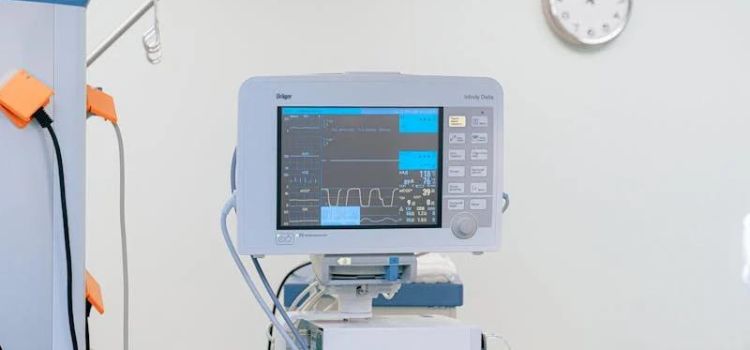The maternal heart rate increases with contractions due to increased demand for oxygen and nutrients for both the mother and the fetus. This higher heart rate ensures adequate blood flow, promoting oxygenation and eliminating waste products during labor.

Additionally, the increased heart rate helps the mother cope with the physical stress of contractions and maintain blood pressure. This physiological response is vital for a healthy delivery and supports the overall well-being of both the mother and the baby.
Understanding Contractions And Maternal Heart Rate
During contractions, maternal heart rate increases due to the body’s need for additional oxygen and nutrients. This physiological response ensures optimal blood circulation to support both the mother and the baby during the delivery process.
Contractions are a fundamental part of the childbirth process, signaling that labor has begun and the baby is on the way. These powerful uterine muscle contractions help push the baby through the birth canal. However, have you ever wondered why maternal heart rate increases during contractions?
Let’s explore this intriguing phenomenon and understand the relationship between contractions and heart rate.
What Are Contractions?
Contractions are rhythmic tightening and relaxing of the uterine muscles during labor. They are a natural and essential process that helps the baby descend and prepares the mother’s body for childbirth. Contractions are commonly described as intense waves that come and go in regular intervals.
How Do They Affect The Body?
Contractions exert a significant impact on the mother’s body as it goes through the labor process:
- Intensifying sensations: Contractions cause discomfort, as the uterine muscles contract and tighten. This is often described as a sensation of pressure or cramping in the lower abdomen and back.
- Cervical dilation: With every contraction, the cervix slowly dilates and effaces (thins out), allowing the baby to move downward.
- Rupture of membranes: Sometimes, the force of contractions can lead to the rupture (breaking) of the amniotic sac, releasing the amniotic fluid.
- Progressing labor: The frequency, duration, and strength of contractions increase as labor progresses, aiding in the baby’s descent.
Relationship Between Contractions And Heart Rate
The intricate connection between contractions and maternal heart rate is fascinating. During contractions:
- Increased demand for oxygen: As contractions intensify, the uterine muscles require more oxygen to sustain their effort, leading to an increase in heart rate.
- Cardiovascular response: The body responds to the increased demand by directing more blood flow to the uterus, which further enhances the heart’s pumping action.
- Adrenaline release: The physical stress of contractions triggers the release of adrenaline, stimulating the heart and raising the maternal heart rate.
- Alleviating oxygen deprivation: The surge in heart rate ensures that sufficient oxygen-rich blood reaches the uterus to prevent oxygen deprivation in the baby.
Understanding the relationship between contractions and maternal heart rate sheds light on the physiological changes occurring during labor. This miraculous process enables the body to adapt to the demands of childbirth, ensuring the safe arrival of the little one.
Physiological Changes During Contractions

During contractions, maternal heart rate increases due to physiological changes. The body’s response to the intense muscle contractions leads to increased cardiac output, ensuring sufficient oxygen supply to both the mother and the baby.
Contractions during labor result in various physiological changes within the body. These changes are necessary to facilitate the process of childbirth and ensure the well-being of both the mother and the baby. In this section, we will explore the specific physiological changes that occur during contractions.
The Role Of Oxytocin In Contractions
Oxytocin, commonly known as the “hormone of love,” plays a crucial role during contractions. Here’s how it affects the body:
- Oxytocin stimulates the muscles within the uterus, causing them to contract and progress the labor process.
- It plays a significant role in initiating and strengthening contractions, allowing the cervix to dilate and the baby to descend further into the birth canal.
- Oxytocin release is primarily triggered by the stretching of the cervix and positive feedback from contractions. This creates a cycle where contractions increase oxytocin release, which in turn intensifies contractions.
Increased Blood Flow To The Uterus
During contractions, there is a notable increase in blood flow to the uterus. Here’s why this happens:
- Contraction-induced compression of the blood vessels momentarily reduces blood flow to the uterus.
- Once the contraction subsides, there is a surge of blood flow to replenish the oxygen and nutrient supply, ensuring the baby’s well-being.
- This increased blood flow helps maintain the overall oxygenation and nutrition levels required for the baby’s development.
Changes In Cardiac Output
The body responds to contractions by making significant changes in cardiac output. Here’s how this happens:
- Cardiac output, the amount of blood pumped by the heart in one minute, increases during contractions.
- This increase in cardiac output is mainly due to an elevated heart rate, which is necessary to provide adequate oxygen and nutrients to both the mother and the baby.
- The heart pumps with more force during contractions, enabling proper blood circulation and sustaining the demands associated with labor.
Understanding the physiological changes during contractions helps us appreciate the complexity of the childbirth process. Oxytocin’s role in initiating and intensifying contractions, along with increased blood flow to the uterus and changes in cardiac output, contribute to successful labor and delivery.
Factors Affecting Maternal Heart Rate During Contractions
During labor, a woman’s heart rate naturally increases with each contraction. This increase in maternal heart rate is influenced by a variety of factors, such as pain and stress response, maternal position during labor, and maternal hydration and nutrition.
Let’s delve into each of these factors to understand how they impact the heart rate during contractions:
Pain And Stress Response
- Pain response: The intensity of pain experienced during contractions can lead to an increased heart rate. As the body perceives pain, it responds by releasing stress hormones, such as adrenaline, which can cause the heart rate to rise.
- Stress response: The emotional and physical stress associated with labor can also contribute to an elevated heart rate. The body’s stress response triggers the release of stress hormones, activating the “fight or flight” response and increasing heart rate.
Maternal Position During Labor
- Upright positions: Standing, walking, or being in an upright position during contractions can help maintain a lower heart rate compared to lying down. These positions promote better blood circulation, reducing the strain on the heart.
- Sitting or reclining positions: Sitting or reclining during labor may cause a higher heart rate due to restricted blood flow and increased pressure on the abdomen. This positioning can impede cardiovascular function.
Maternal Hydration And Nutrition
- Hydration: Proper hydration plays a key role in regulating heart rate during labor. Dehydration can intensify contraction-related discomfort and stress, leading to an increased heart rate. It is crucial for mothers in labor to stay well-hydrated.
- Nutrition: Providing the body with essential nutrients and energy through proper nutrition can help maintain a stable heart rate during contractions. A well-nourished body is better equipped to handle the physical demands of labor, potentially lowering the heart rate response.
Understanding the factors influencing maternal heart rate during contractions can help expectant mothers and their healthcare providers optimize the birthing experience.
By managing pain and stress, choosing favorable positions, and prioritizing hydration and nutrition, mothers can potentially maintain a healthier heart rate during this pivotal stage of childbirth.
Remember, every woman’s labor experience is unique, and consulting with healthcare professionals is essential to ensure personalized care and support throughout the birthing journey.
The Role Of Oxytocin On Maternal Heart Rate

Oxytocin plays a vital role in increasing maternal heart rate during contractions, ensuring effective delivery and bonding between mother and baby. This hormone triggers uterine contractions and enhances the emotional connection between mother and child.
Oxytocin Release During Contractions
Oxytocin, often referred to as the “love hormone,” plays a vital role during labor and delivery. This hormone is released by the pituitary gland in response to the stretching of the cervix and uterus. Here’s how oxytocin functions during contractions:
- Oxytocin release: The onset of contractions triggers the release of oxytocin into the bloodstream. This hormone is released in pulsatile bursts and acts as a signaling molecule, coordinating various physiological changes during labor.
- Uterine contractions: Oxytocin stimulates the muscles of the uterus to contract and helps to strengthen and regulate the contractions. These contractions assist in the effacement and dilation of the cervix, ultimately facilitating the delivery of the baby.
- Positive feedback loop: Oxytocin release is tightly controlled through a positive feedback loop. As the contractions increase in intensity and frequency, more oxytocin is released, which in turn leads to stronger contractions. This cycle continues until the baby is delivered.
- Emotional bonding: Along with its role in uterine contractions, oxytocin also stimulates feelings of love, attachment, and bonding. This hormone helps create a strong emotional connection between the mother and her newborn.
Effects On Heart Rate And Blood Pressure
The release of oxytocin during contractions not only affects the uterus but also has significant effects on the mother’s cardiovascular system. Here are the notable effects on heart rate and blood pressure:
- Increased heart rate: Oxytocin stimulates the release of catecholamines, such as epinephrine and norepinephrine, which lead to an increase in heart rate. The surge in heart rate is necessary to supply oxygen and nutrients to the contracting uterus and to maintain the mother’s overall cardiovascular function.
- Elevated blood pressure: Oxytocin also influences blood pressure. It causes vasoconstriction, narrowing the blood vessels, which results in a temporary increase in blood pressure. This rise in blood pressure ensures adequate blood flow to the uterus and other vital organs during labor.
- Adaptation to stress: The rise in heart rate and blood pressure during contractions reflects the body’s adaptive response to the stressful event of labor. These physiological changes help redirect blood flow and resources to support the mother and the baby during this demanding process.
Understanding the role of oxytocin in labor is crucial for healthcare providers and expectant mothers alike. By comprehending how this hormone affects heart rate and blood pressure, we can ensure a safe and healthy birthing experience for both mother and baby.
Influence Of Adrenaline And Cortisol On Maternal Heart Rate
During contractions, the maternal heart rate increases due to the release of adrenaline and cortisol. These hormones help to prepare the body for the physical stress of labor and delivery.
The increased heart rate experienced by expectant mothers during contractions is influenced by the release of hormones such as adrenaline and cortisol. These hormones play a crucial role in the body’s fight-or-flight response and have a direct impact on heart rate during labor.
Let’s explore how these hormones affect maternal heart rate:
Fight-Or-Flight Response
- Adrenaline surge: During labor, the body is under stress, triggering the release of adrenaline, also known as epinephrine. This hormone is responsible for preparing the body for action and helps the mother endure the physical demands of childbirth.
- Cortisol release: Alongside adrenaline, cortisol, the primary stress hormone, is also released during contractions. It helps increase blood sugar levels and provide the mother with an energy boost to cope with the demands of labor.
Impact On Heart Rate During Contractions
- Increased heart rate: Adrenaline and cortisol both contribute to the increased heart rate observed during contractions. These hormones cause the heart to pump faster, ensuring that sufficient oxygen and nutrients are delivered to the muscles involved in the birthing process.
- Enhanced blood flow: As a result of the increased heart rate, blood flow is optimized, enabling better oxygenation and nutrient delivery to the uterus and placenta. This ensures the baby receives the necessary oxygen and nutrients for a healthy delivery.
- Sustaining energy levels: Adrenaline and cortisol help maintain the mother’s energy levels by mobilizing glucose reserves stored in the body. This ensures she has the stamina to endure the prolonged process of labor and continue pushing during contractions.
- Facilitating oxygen transport: Adrenaline and cortisol also enhance the oxygen-carrying capacity of the blood by dilating blood vessels. This ensures an adequate supply of oxygen reaches the muscles involved in labor, including the uterus.
The release of adrenaline and cortisol during contractions directly affects maternal heart rate. The surge of these hormones prepares the body for the physical demands of childbirth, enhancing blood flow, sustaining energy levels, and facilitating oxygen transport.
The increased heart rate ensures that both mother and baby receive the necessary support and resources for a successful delivery.
Other Hormones Involved
During contractions, maternal heart rate increases due to the release of other hormones involved in labor. These hormones help regulate blood flow and oxygen supply to the uterus, supporting the intense muscular contractions that occur.
During childbirth, many physiological changes occur in a woman’s body. One interesting phenomenon is the increase in maternal heart rate with contractions. This rise in heart rate is a result of various factors, including hormones.
Understanding the role of these hormones can shed light on why maternal heart rate increases during contractions.
Prostaglandins And Their Effect On Heart Rate
Prostaglandins are hormone-like substances that play a crucial role in labor and delivery. They promote uterine contractions and help to ripen and soften the cervix. Prostaglandins also have an impact on the cardiovascular system, causing blood vessels to constrict.
The constriction of blood vessels leads to an increase in blood pressure, which in turn elevates the heart rate. The release of prostaglandins during contractions contributes to the higher heart rate observed in expectant mothers.
Role Of Endorphins And Their Impact On Maternal Heart Rate
Endorphins, commonly known as “feel-good” hormones, are released during labor. They act as natural painkillers, helping to reduce discomfort and increase relaxation. The release of endorphins also triggers a cascade of physiological changes, including an increase in maternal heart rate.
Endorphins promote a positive emotional state, which can stimulate the release of adrenaline and norepinephrine. Adrenaline and norepinephrine raise the heart rate to ensure an adequate blood supply to the uterus and fetus.
Therefore, the surge of endorphins during labor contributes to the maternal heart rate increase.
The increase in maternal heart rate during contractions can be attributed to the influence of hormones. Prostaglandins cause blood vessels to constrict, resulting in higher blood pressure and heart rate.
Additionally, the release of endorphins during labor triggers a cascade of events that lead to an elevated heart rate.
These hormonal changes are essential for supporting the physiological processes necessary for a successful childbirth.
Breathing And Relaxation Techniques For Maternal Heart Rate

During contractions, the maternal heart rate increases due to a combination of factors such as stress, pain, and increased demand for oxygen. Breathing and relaxation techniques can help reduce anxiety and promote better blood circulation, leading to a more comfortable birthing experience.
During labor, a woman’s body goes through various physiological changes to support the delivery of her baby. One of these changes is an increase in maternal heart rate with contractions.
This increased heart rate is a normal response as the body works to provide adequate oxygen and nutrients to the uterus and the baby.
Deep Breathing Exercises
Deep breathing exercises are a crucial technique to help manage the increase in maternal heart rate during contractions. By taking slow, deep breaths, women can effectively lower their heart rate and promote relaxation.
The deep inhales and long exhales help oxygenate the muscles and calm the mind. Deep breathing can also help distract from the discomfort of contractions and enhance focus during labor.
Visualization And Guided Imagery
Visualization and guided imagery techniques can be powerful tools in managing a higher heart rate during labor. Imagining a peaceful and serene setting, such as a beach or a garden, can help divert attention from the pain and focus on relaxation.
Guided imagery involves listening to calming audio recordings or having a birth partner guide the woman through visualizations. These techniques can reduce anxiety, activate the parasympathetic nervous system, and subsequently lower the heart rate.
Remember, proper breathing and relaxation techniques are essential for managing the increased heart rate during labor. By incorporating deep breathing exercises and visualization techniques, women can help create a more calm and controlled birthing environment.
Positioning And Movement Of Maternal Heart Rate
During contractions, maternal heart rate increases due to the excess demand for oxygen and nutrients required to support the uterus and placenta. This positioning and movement ensure adequate blood flow to the uterus, allowing for the transportation of vital resources to the growing fetus.
Different Labor Positions And Their Impact On Heart Rate
During labor, the positioning and movement of the mother can play a significant role in the increase of maternal heart rate. Let’s explore different labor positions and how they can impact heart rate:
Standing or Walking:
- Blood circulation is enhanced, promoting oxygen flow to the muscles.
- Upright posture encourages better uterine contractions, potentially increasing heart rate.
Squatting:
- Gravity assists in the descent of the baby, which may result in more intense contractions and an elevated heart rate.
- The open position of the pelvis allows for easier passage of the baby through the birth canal.
Kneeling or Hands and Knees:
- Reduces pressure on the uterus and improves blood circulation.
- May help alleviate back pain.
- Can promote optimal fetal positioning.
Sitting:
- Provides a more relaxed position for the mother, potentially reducing anxiety and stress.
- Allows for proper breathing techniques during contractions.
Side-Lying:
- Enables relaxation and rest between contractions.
- Can be helpful for mothers who experience discomfort in other positions.
Birthing Ball:
- Assists in maintaining an upright position while providing support and comfort.
- Encourages gentle movement that can help reduce tension and promote optimal blood flow.
Gentle movement and changing positions throughout labor can have positive effects on heart rate. By adapting different positions, mothers can optimize their comfort and encourage effective labor progression.
It is important to note that each woman’s experience may vary, and it is crucial to consult with healthcare professionals to determine the most suitable labor positions based on individual circumstances.
Supportive Interventions
Maternal heart rate increases with contractions due to the body’s response to stress. Supportive interventions during labor and delivery can help manage this increased heart rate, ensuring the well-being of both the mother and the baby.
During labor, the increase in maternal heart rate with contractions is a common phenomenon. However, there are various supportive interventions that can help manage this increased heart rate and promote relaxation.
Two effective techniques that have shown positive results are hydrotherapy and warm showers, as well as massage and acupressure techniques.
Hydrotherapy And Warm Showers
- Submerging in warm water can provide immense relief during labor by easing the intensity of contractions and reducing the strain on the mother’s cardiovascular system.
- Water immersion promotes relaxation, diminishes anxiety, and helps manage the fluctuations in heart rate caused by contractions.
- It is crucial to maintain a suitable water temperature between 37-38 degrees Celsius (98.6-100.4 degrees Fahrenheit) to prevent hyperthermia or hypothermia.
- The buoyancy of water also aids in labor pain management as it reduces the weight and pressure on the mother’s body, allowing her to move more freely.
- Hydrotherapy has been shown to lower stress hormone levels and decrease the perception of pain, contributing to overall maternal well-being during labor.
Massage And Acupressure Techniques
- Massage and acupressure are valuable supportive interventions during labor that can help alleviate maternal heart rate fluctuations and promote relaxation.
- Gentle massage techniques, such as effleurage and kneading, aid in muscle relaxation and stimulate the release of endorphins, the body’s natural pain-relieving hormones.
- Acupressure involves applying pressure to specific points on the body, such as the hands, feet, and back, which can help alleviate pain and reduce stress.
- Engaging in massage and acupressure with the support of a partner or a trained professional can foster a sense of emotional connection and support, enhancing the overall labor experience.
- These techniques not only help manage an elevated heart rate during contractions but also contribute to a calming atmosphere, promoting a positive and empowering birthing experience.
Supportive interventions like hydrotherapy, warm showers, massage, and acupressure can assist in managing an increased maternal heart rate during contractions. These techniques provide relaxation, pain relief, and promote a nurturing environment, contributing to a more positive labor experience for the mother.
Considering these interventions and discussing them with your healthcare provider can help create an optimal birth plan for you.
Frequently Asked Questions Of Why Does Maternal Heart Rate Increase With Contractions
Why Does Maternal Heart Rate Rise With Contractions?
During contractions, the maternal heart rate rises due to increased demand for oxygen and nutrients.
Does The Mothers Heart Rate Increase During A Contraction?
Yes, the mother’s heart rate does increase during contractions.
What Causes An Increase In The Pulse Rate During Labor And Delivery?
During labor and delivery, the pulse rate increases due to the intense physical exertion and emotional stress.
Conclusion
Maternal heart rate increasing with contractions is a normal physiological response during childbirth. The body goes through a series of changes to accommodate and support the labor process.
As contractions intensify, the heart works harder to supply oxygen and nutrients to both the mother and the baby. This increased heart rate also helps to remove waste products from the body. It is a vital mechanism that ensures the wellbeing of both the mother and the baby during labor.
Understanding why maternal heart rate increases with contractions is important for healthcare providers and expectant mothers. By monitoring heart rate, medical professionals can assess the progress of labor and identify any potential complications.
In turn, mothers can have peace of mind knowing that their increased heart rate is a normal part of the birthing process. Remember, each pregnancy is unique, and changes in maternal heart rate may vary.
It is always crucial to consult with a healthcare professional for personalized guidance throughout the labor journey.
Leave a Reply